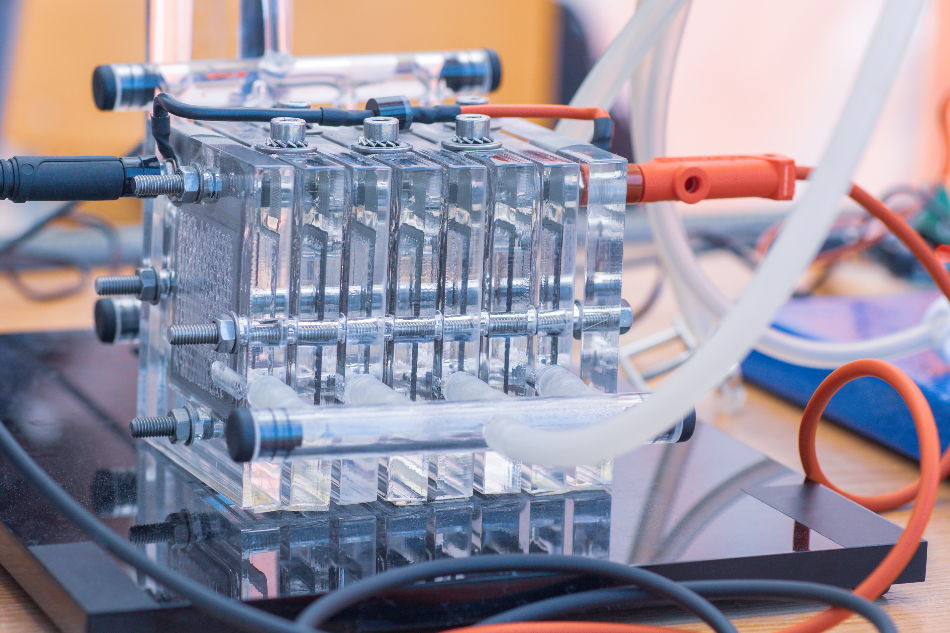Largely considered to be salts that are molten at room-temperature with organic cations and inorganic anions, ionic liquids have a distinctive number of physical and chemical qualities that make them ideal for use in clean energy production.

Image Credit: Kaca Skokanova/Shutterstock.com
Ionic liquids have high thermal and electrochemical stability in conjunction with low volatility, which makes them ideal electrolytes for various types of batteries and other storage devices.
Electrolytes
Society is increasingly turning towards clean energy production with electricity made from sources like wind and solar. These sources of energy are, however, intermittent nature. The sun doesn't permanently shine and the wind isn't constantly blowing. Addressing this issue requires the development of safe, sustainable energy storage technology, like batteries, fuel cells, and supercapacitors. Electrodes and electrolytes are the predominant components in conventional energy storage systems. Electrolytes are the substances where the essential transport of ions occurs between electrodes during charge-discharge operations. As electrolytes, ionic liquids deliver superb performance as a result of their high ionic conductivity, good thermal stability, and broad liquidity range. They are also non-volatile and non-toxic.
The principal requirements for an electrolyte are high conductivity, non-flammability, non-volatility, thermal stability, and good electrochemical window, which is described as the limiting potential range, whereby the electrolyte is electrochemically steady without undesirable redox reactions.
Problems with the use of electrolytes
Typical electrolytes are made up of ionic salts in volatile organic solvents. There are major safety concerns about these electrolytes, as they can produce sparks when charging occurs at high rates, possibly triggering an explosion. Also, these toxic electrolytes have been known to leak, causing both health and ecological problems.
The prohibitive cost of ionic liquids is one of the main factors hampering their broader adoption, and some research has been focused on reducing the cost associated with ionic liquids by leveraging low-cost cations or anions. Some researchers developed low-cost, bio-based ionic liquids of comparable performance made from waste by-products, such as a liquid extract made from cashew nutshells. Because the transformation of waste to value-added electrolytes could be a dual benefit, reuse approaches can be a solution for addressing both pollution and sustainable energy storage.
Fuel Cells
Used in spacecrafts and submarines, fuel cells are a popular technology for sustainable energy, because of their high energy efficiency and low ecological impact. These devices directly change chemical energy to electricity and a water by-product.
Primarily, acidic or basic aqueous solutions have been used as the electrolyte for typical fuel cells, and although fuel cell technology has been around for 150 years, it has been based entirely on hydronium ions or hydroxide ions as proton carriers, until only recently.
The effective potential range of fuel cells has been limited to below 1 V, due to aqueous electrolyte use. Furthermore, the operating temperature range for fuel cells has been restricted to less than 100 degrees Celsius. According to experts, these issues might be solved through the use of ionic liquids as the electrolytes.
Dye-Sensitized Solar Cells
Dye-sensitized solar cells (DSSCs) are a newer type of photovoltaic device that transforms solar radiation into electricity in a less complicated and more cost-effective way than standard semi-conducting photovoltaics. As a bonus, DSSCs can be flexible and multi-colored.
In theory, the maximum efficiency of a DSSC is around 20 percent. However, simple structure, easy production, and a relatively low cost have all made the DSSC a popular technology.
An electrolyte is one of the main aspects of DSSC, the fundamental function of which is to establish a conducting path that supports electron transfer by delivering electrons to regenerate oxidized dye.
Unstable solvent and toxic ingredients are major drawbacks of the current DSSC electrolyte, and a study has revealed that ionic liquids are a promising replacement.
Additionally, ionic liquids are better suited for flexible DSSCs and along with the large scale production of thin-film electrolytes, ionic liquids may change the face of photovoltaic technology.
Sources:
https://www.sciencedirect.com/science/article/pii/S1005030218302640
https://www.intechopen.com/books/progress-and-developments-in-ionic-liquids/ionic-liquids-ionic-liquid-crystals-for-safe-and-sustainable-energy-storage-systems
https://www.sigmaaldrich.com/technical-documents/articles/material-matters/ionic-liquids-for.html
Disclaimer: The views expressed here are those of the author expressed in their private capacity and do not necessarily represent the views of AZoM.com Limited T/A AZoNetwork the owner and operator of this website. This disclaimer forms part of the Terms and conditions of use of this website.